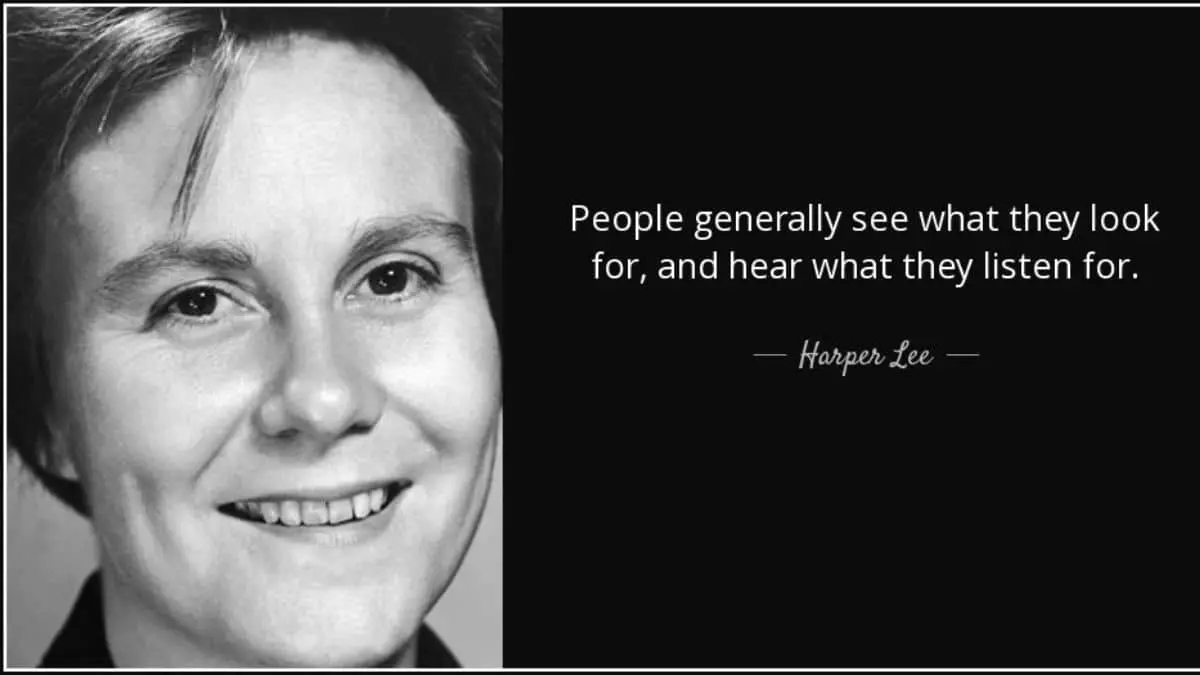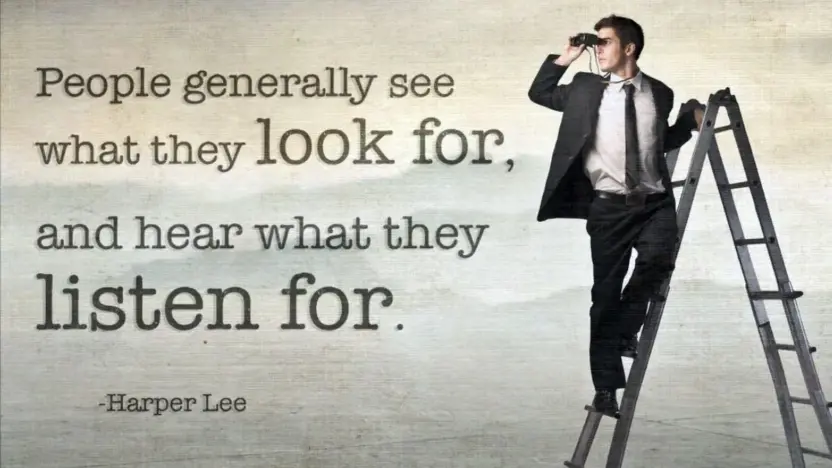Imagine walking through a bustling city street, your senses bombarded by a cacophony of sights, sounds, and sensations. In the midst of this sensory overload, your brain sifts through the information, attempting to make sense of the world around you. It’s a remarkable process, but one that’s far from objective. As the quote suggests, “People generally see what they look for, and hear what they listen for.” This deceptively simple statement encapsulates the intricate interplay between perception and bias that shapes our understanding of reality.
Seeing What You Look For
Our perception of the world around us is not a straightforward recording of objective reality; rather, it’s a complex and highly personalized interpretation. This interpretation is heavily influenced by our expectations, desires, and past experiences. As a result, we often see what we’re actively searching for, whether consciously or subconsciously.
- The Power of Expectations:
- Human beings are creatures of habit, and we tend to build mental models of how the world works. These mental models shape our expectations.
- When we encounter something that aligns with our expectations, it often stands out more prominently in our perception.
- Example: If you expect a restaurant to have poor service due to online reviews, you may notice small mistakes by the staff more readily than the positive aspects of your dining experience.
- Confirmation Bias:
- Confirmation bias is a well-known cognitive bias that causes us to seek out and favor information that confirms our existing beliefs.
- This bias plays a significant role in shaping what we “look for” in our daily lives.
- Example: If someone strongly believes in a particular political ideology, they may actively seek out news sources and information that support their views while ignoring contradictory information.
- Cultural and Societal Influences:
- Our cultural background and societal influences also contribute to what we perceive.
- Cultural norms and values can shape our perceptions of what is considered “normal” or “acceptable” in various contexts.
- Example: In some cultures, direct eye contact is seen as a sign of confidence, while in others, it may be interpreted as disrespectful or confrontational.
- Inattentional Blindness:
- Sometimes, we are so focused on one aspect of our environment that we completely overlook other significant details.
- This phenomenon, known as inattentional blindness, highlights our ability to “see” only what we are actively paying attention to.
- Example: You might be engrossed in a conversation on your phone while walking and completely miss a street performer or an interesting shop along the way.
- The Influence of Emotions:
- Emotions can profoundly affect our perception.
- When we are in a particular emotional state, we are more likely to notice things that align with that emotion.
- Example: If you’re feeling anxious, you may be hypersensitive to potential threats in your environment, even if they are relatively minor.
Hearing What You Listen For
Our perception doesn’t stop at what we see; it extends to what we hear as well. Just as with vision, our auditory perception is heavily influenced by our expectations, biases, and selective attention. Here’s a closer look at how “hearing what you listen for” manifests in our lives:
- Selective Listening:
- Selective listening is a common behavior where we focus on specific elements of a conversation while filtering out others.
- This selective attention often leads us to hear what aligns with our interests, concerns, or beliefs.
- Example: In a heated debate, people may hear and remember arguments that support their own stance while ignoring opposing viewpoints.
- Confirmation Through Sound:
- Similar to confirmation bias in visual perception, we tend to hear information that confirms our existing beliefs or expectations.
- When information matches our preconceptions, it resonates more strongly with us.
- Example: If you believe a certain musician is exceptionally talented, you’re more likely to hear and appreciate their skills in a song, even if it’s not their best work.
- Emotional Influence on Hearing:
- Emotions can color our auditory perception as well. We often hear what resonates with our current emotional state.
- For instance, when we’re in a joyful mood, we’re more likely to notice and appreciate positive and uplifting aspects of music or conversations.
- Filtering Out Unfamiliar or Dissonant Sounds:
- Just as we filter out visually incongruent information, we may also filter out sounds that don’t fit our mental model of a situation.
- This filtering can cause us to miss important cues or perspectives.
- Example: When attending a foreign language event, you might tune out conversations you can’t understand, missing potential connections or interesting experiences.
- Echo Chambers in Listening:
- In the digital age, social media and online communities can create “echo chambers” where people primarily hear and reinforce their existing beliefs.
- By following like-minded individuals or consuming content that aligns with their views, individuals essentially “listen for” information that confirms their biases.
- This can lead to polarization and a lack of exposure to diverse perspectives.
- Active Listening vs. Passive Hearing:
- Active listening involves consciously engaging with a speaker or a piece of music, striving to understand and appreciate the nuances.
- Passive hearing, on the other hand, is when we hear without truly listening, often due to distractions or a lack of interest.
- Being aware of the difference between the two can help us become better listeners and avoid hearing only what we expect or desire.

Overcoming Bias and Enhancing Perception
Now that we’ve explored the powerful impact of bias and selective perception on both what we see and hear, it’s essential to discuss strategies for overcoming these tendencies. By actively working to enhance our perception and reduce bias, we can become more open-minded, empathetic, and effective in our interactions. Here are some practical steps:
- Awareness of Bias:
- The first step in overcoming bias is acknowledging its existence. Understand that bias is a natural part of human cognition.
- Reflect on your own biases and try to identify when they influence your perceptions and decisions.
- Diverse Exposure:
- Seek out diverse perspectives and experiences. Expose yourself to different cultures, viewpoints, and backgrounds.
- Read books, watch documentaries, and engage in conversations that challenge your existing beliefs.
- Critical Thinking:
- Develop critical thinking skills to evaluate information objectively. Question the sources of information and their potential biases.
- Encourage yourself to consider alternative explanations and viewpoints.
- Mindfulness and Present Moment Awareness:
- Practice mindfulness to become more aware of your thoughts and feelings in the present moment.
- Mindfulness can help you notice when bias is creeping into your perception and allow you to consciously choose a more open-minded perspective.
- Active Listening:
- When engaged in conversations, practice active listening. Give your full attention to the speaker without immediately formulating your response.
- Ask clarifying questions to ensure you understand their viewpoint accurately.
- Empathy Building:
- Work on developing empathy by trying to understand the emotions and experiences of others.
- Putting yourself in someone else’s shoes can reduce the impact of bias on your perceptions.
- Challenge Your Assumptions:
- Actively challenge your assumptions and stereotypes. Recognize that not everyone fits neatly into preconceived categories.
- Engage in open dialogue with individuals who hold different beliefs to gain a deeper understanding of their perspectives.
- Balanced Information Consumption:
- Consume information from a variety of sources with differing perspectives. Avoid the trap of only seeking out information that confirms your existing beliefs.
- Consider the credibility and reliability of your information sources.
- Mindful Media Consumption:
- Be aware of how media can influence your perception. Recognize that media outlets often have their own biases.
- Analyze news and media critically rather than accepting information at face value.
- Continual Self-Reflection:
- Regularly reflect on your thoughts and actions. Assess whether bias is influencing your decisions or perceptions.
- Be open to learning and growing, recognizing that it’s a continuous process.
Conclusion
In the intricate dance of human perception and bias, the quote, “People generally see what they look for, and hear what they listen for,” serves as both a poignant reminder and a call to action. Our minds are not impartial recorders of reality; they are filters through which we interpret the world around us. Understanding the profound implications of this phenomenon is the first step toward a more enlightened, empathetic, and open-minded existence.



